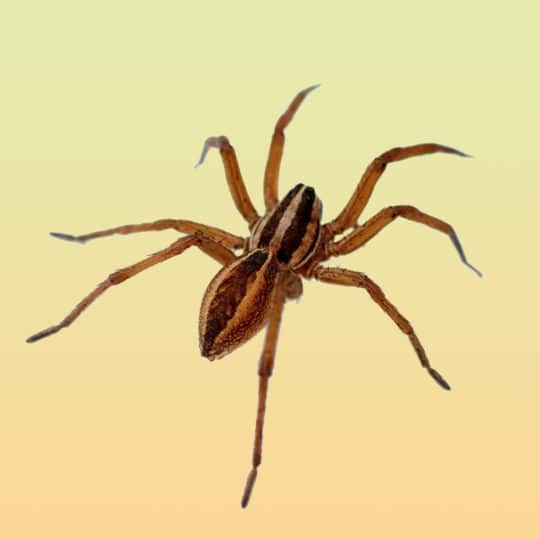Table Of Content

Spiderlings disperse aerially and, consequently, wolf spiders have wide distributions. They can be found in a wide range of habitats both coastal and inland — anywhere they can find insects to eat! These include shrub lands, woodland, wet coastal forest, alpine meadows and suburban gardens. There are more than 100 genera and about 2,300 species of wolf spiders; 200 species live in the United States. This family belongs to the order of Araneae, which includes all known spiders.
Identifying common spiders
If you see them inside your house, put down glue traps to catch them. They don’t generally breed indoors, so if you see one in your basement, it doesn’t necessarily mean you have an infestation. You might not see them, but they’re all around you — and that’s a good thing. Your garden spiders, and learn how to entice more into your yard.
Where Do Wolf Spiders Live?
Identifying features of wolf spiders are their eight eyes arranged in three rows, banded furry legs, and a flattened head. The medium-sized brown spiders grow 0.4” to 1.4” (10 – 35 mm) in size. The American house spider is a common tan to dark brown spider. The small brown spider has a bulbous abdomen, long legs, and the appearance of a brown widow spider.
Spiders of Alabama: 58 spiders you should know - AL.com
Spiders of Alabama: 58 spiders you should know.
Posted: Thu, 02 Jun 2016 07:00:00 GMT [source]
Black and yellow garden spider
Spiders rarely bite more than once, so multiple bites are usually caused by insects such as fleas, bedbugs, chiggers, ticks, mites and biting flies. Many of the spiders in Maryland possess venom, but the black widow is the only native Maryland spider that is dangerous to people. All other venomous Maryland spiders either have too little venom to affect people or their venom is specially adapted for their prey. Dark or orange-brown, domestic house spiders have a pale mark on the breastplate. Hobo spiders have brown bodies with a pattern of darker stripes. They’re predominantly found in the northwest U.S. in holes and cracks and are non-aggressive.
Size
The small yellow house spider can measure 0.19” to 0.35” (5 – 9 mm) with a leg span up to 1” (25 mm). The brown widow spider is a venomous spider with a bulbous light brown to dark brown body and distinctive hourglass marking on the side of its abdomen. The brown widow’s markings can be orange or dull yellow, and it also has colorful markings on its back. The black house spider is identified by its dark gray to black oval abdomen covered in tiny white markings.
Everything You Need to Know About Wolf Spiders
Wolf spiders typically live outdoors, but the furry brown spiders can enter homes in the fall when the temperature drops. They prefer hiding in crevices, closets, around doors, and basements. Brown widow spiders are typically found in dark, undisturbed areas of your home like behind furniture, basements, attics, or garages. Inside the homes, black widows usually lurk in dark, dimly lit places like crevices, closets, cluttered areas, basements, and attics.

Funnel weavers/ Grass spiders

Crab spiders are small, often brightly colored, and have two front legs that are larger than the others. Creepily, “They do not spin a web but instead wait in hiding for prey,” as shared by Britannica. Crab spiders are small to medium-sized spiders (1/10- to 2/5-inch long) ranging in color from yellow or red to brown or gray. They are generally dark-colored, usually brownish or grayish, with white markings.
Cellar Spider
You typically see them slung between garden plants and in forests. When the male Black House spider finds a female in their webs, the male plucks the web of the female to attract her attention. Once the male has made sure that the female will be receptive, he can safely approach and inseminate her with his palps. Eye pattern represents the first spider identification clue when deciding between families. The picture at the top of the page, for example, shows a spider with two rows of eyes. That’s the basic form for members of the nursery web spider category.
Wolf spiders are often confused with the Brown Recluse spider, however, they lack the violin-shaped marking of the recluse. Namely, the wolf spider will not use its web to hunt its prey, while the common house spider will rely on its webs quite heavily. That’s because the funnel web is effective at capturing the prey, which will trigger the spider’s senses and cause it to strike the prey and kill it.
Lycosa lapidosa will take small toads and frogs while Lycosa obscuroides has been noted biting and killing a large toad within one hour. Both species will use their venom to hunt their prey, which is mostly insects and other smaller bugs and animals. For that reason, the venom doesn’t need to be very potent to kill the prey, so it will not cause a great deal of damage to humans. Common house spiders (Tegenaria Domestica) like to hide under furniture and in corners of your home, too. It is quite a shy spider and once it spots you, it will try to run away as quickly as possible. Also called the black-footed spider, yellow sac spiders can inflict a painful venomous bite.
They do not like people and will likely scurry away when they hear your footsteps. Like their namesake animal, wolf spiders chase and leap on their prey instead of weaving a web to entrap them. Typically, their diet consists of insects like other small spiders, ants, grasshoppers, and more—though they have been known to also hunt small frogs and other reptiles. They are nocturnal creatures and will do the majority of their hunting and wandering at night. Wolf spiders use their keen eyesight, camouflage, speedy movements and high sensitivity to vibrations to help them avoid predators such as lizards, birds and hunting wasps. There are nearly 2,400 wolf spider species across 125 genera, according to the Integrated Taxonomic Information System (ITIS).
American grass spiders are a type of brown funnel weaver spider with an elongated, oval brown body. Identifying features of the grass spiders are the distinctive dark brown bands running down its cephalothorax, mottled brown abdominal patterns, and spiny, orangey legs. Jumping spiders are identified by their black, tan, or gray bodies with orangish or white markings. They are also covered in dense hairs and have thick, short legs, giving them a scary appearance. Another feature is their eight eyes in three rows, with two prominent eyes in the center.
Wolf spiders are active hunters that patrol the ground for insects, small spiders, and similar prey. They do not use webs to capture prey and actively hunt in the open during the day and night, often living by the thousands in leaf litter and grassy areas. Some wolf spiders build small burrows and defend a territory, others are free-roaming. Because they are so numerous, and such voracious predators, wolf spiders are a very important part of any ecosystem in which they occur. Female spiders may sometimes be seen with their young riding on their backs until they are independent enough to go off on their own.


No comments:
Post a Comment